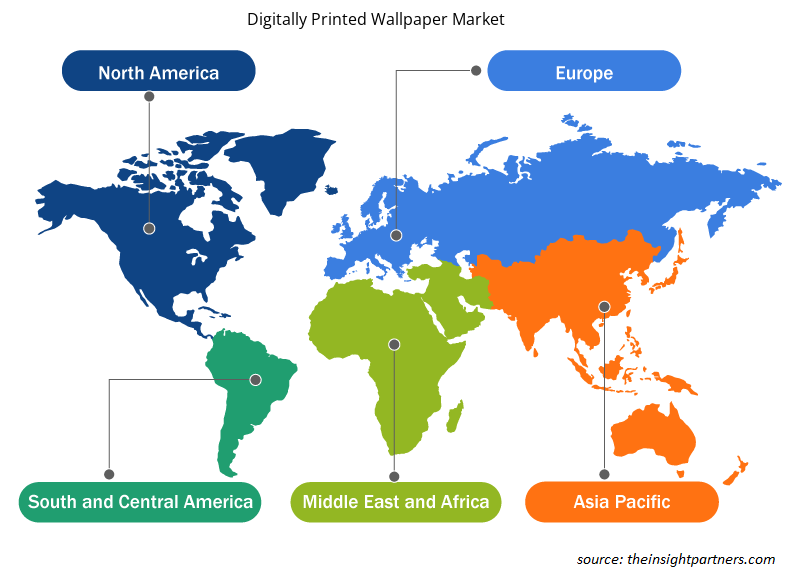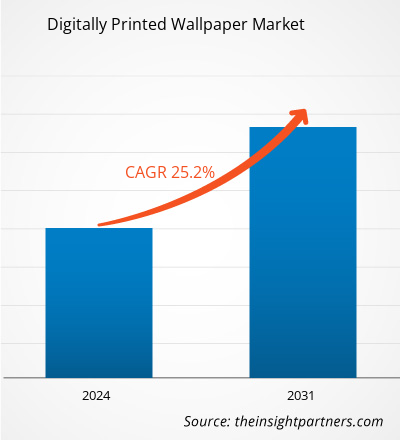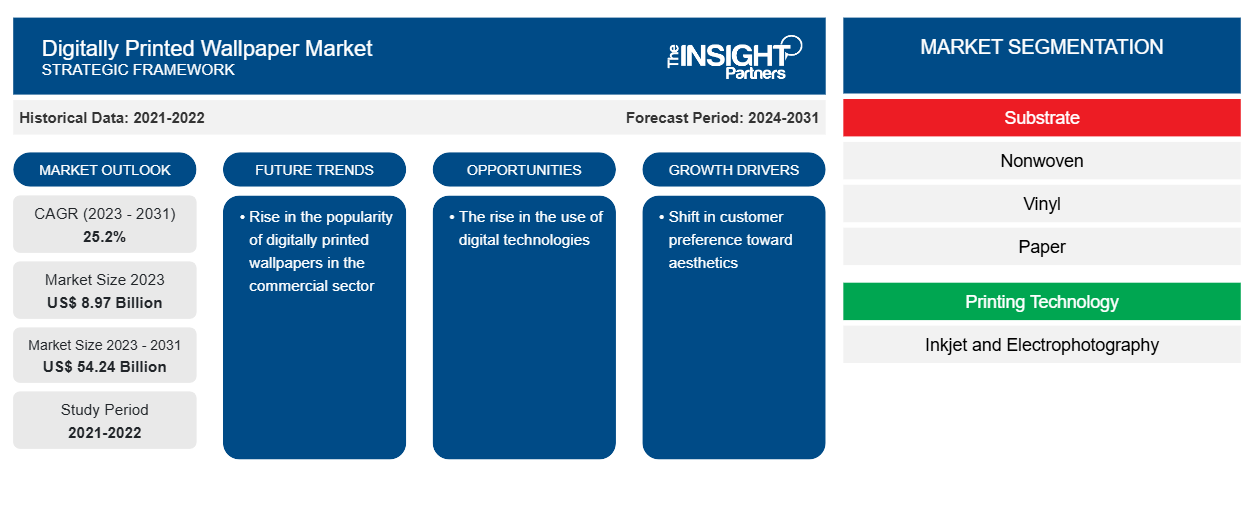Si prevede che il mercato della carta da parati stampata digitalmente raggiungerà i 54,24 miliardi di dollari entro il 2031, rispetto agli 8,97 miliardi di dollari del 2023. Si prevede che il mercato registrerà un CAGR del 25,2% nel 2023-2031. La crescente urbanizzazione e la domanda di carte da parati con elevata durata ed estetica rimarranno probabilmente fondamentali per le tendenze del mercato della carta da parati stampata digitalmente.
Analisi di mercato della carta da parati stampata digitalmente
La crescente domanda di decorazioni per interni personalizzate e su misura, insieme ai progressi nella tecnologia di stampa digitale, sono alcuni dei principali fattori trainanti della crescita del mercato della carta da parati stampata digitalmente. I consumatori e gli arredatori d'interni si stanno concentrando sulla creazione di spazi residenziali e commerciali visivamente accattivanti, il che sta alimentando ulteriormente la crescita del mercato. Uno spostamento delle preferenze dei consumatori verso i rivestimenti murali e un aumento dei progetti fai da te che coinvolgono le carte da parati hanno ulteriormente favorito la crescita del mercato.
Panoramica del mercato della carta da parati stampata digitalmente
La stampa digitale è una tecnologia in cui i sistemi elettronici creano, manipolano e finalizzano un'immagine o un motivo prima di stamparlo su una stampante controllata da computer . I recenti progressi tecnologici e gli sviluppi della stampa hanno consentito la creazione di carte da parati digitali. Tra gli altri vantaggi, la carta da parati stampata in digitale contribuisce all'estetica degli spazi vuoti. La carta da parati digitale offre più creatività, consentendo agli utenti di progettare un rivestimento murale personalizzato che sia esattamente in base alle loro preferenze.
Personalizza questo report in base alle tue esigenze
Riceverai la personalizzazione gratuita di qualsiasi report, comprese parti di questo report, o analisi a livello nazionale, pacchetto dati Excel, oltre a usufruire di grandi offerte e sconti per start-up e università
-
Scopri le principali tendenze di mercato in questo rapporto.Questo campione GRATUITO includerà analisi di dati che spaziano dalle tendenze di mercato alle stime e alle previsioni.
Driver e opportunità del mercato della carta da parati stampata digitalmente
Spostamento delle preferenze dei clienti verso l'estetica per favorire il mercato
Le carte da parati stampate digitalmente integrano opere d'arte e fotografie che completano l'ambiente circostante o lo spazio abitativo. Queste carte da parati offrono diversi vantaggi, tra cui una finitura più vibrante e liscia, valore aggiunto e significato, valore estetico, maggiore protezione delle pareti e altro. C'è uno spostamento nelle preferenze dei clienti verso l'estetica, che sta generando la domanda di carte da parati stampate digitalmente. I clienti preferiscono le carte da parati stampate digitalmente rispetto alle vernici e alle vernici tradizionali per la loro durata e varietà.
Crescente popolarità delle carte da parati stampate digitalmente nel settore commerciale.
Le carte da parati stampate digitalmente stanno guadagnando popolarità nel settore commerciale, che comprende palestre, centri commerciali, centri benessere, ospedali, showroom e altre attività. Inoltre, con i recenti progressi nella stampa digitale , molte aziende hanno adottato carte da parati personalizzate per creare interni aziendali che rappresentano i marchi. La domanda di carta da parati stampata digitalmente è in aumento, poiché gli spazi colorati e la disposizione degli uffici sono uno dei fattori che aumentano l'efficienza e la produttività in azienda. I colori evocano emozioni e influenzano l'umore dei dipendenti. Gli elementi visivi possono essere utilizzati anche per il marketing sul posto di lavoro e per scopi commerciali.
Analisi della segmentazione del rapporto di mercato sulla carta da parati stampata digitalmente
I segmenti chiave che hanno contribuito alla derivazione dell'analisi del mercato della carta da parati stampata digitalmente sono il substrato, la tecnologia di stampa e l'utente finale.
- In base al substrato, il mercato è segmentato in tessuto non tessuto, vinile, carta e altri. Il segmento vinile ha detenuto la quota di mercato maggiore nel 2023.
- In base alla tecnologia di stampa, il mercato è segmentato in getto d'inchiostro ed elettrofotografia. Il segmento a getto d'inchiostro ha detenuto la quota di mercato maggiore nel 2023.
- In base all'utente finale, il mercato è segmentato in residenziale e commerciale. Si prevede che il segmento commerciale crescerà con il CAGR più elevato.
Analisi della quota di mercato della carta da parati stampata digitalmente per area geografica
L'ambito geografico del rapporto sul mercato della carta da parati stampata digitalmente è suddiviso principalmente in cinque regioni: Nord America, Asia Pacifico, Europa, Medio Oriente e Africa e Sud America/Sud e Centro America.
Si prevede che la regione Asia-Pacifico crescerà con il CAGR più elevato. La domanda di spazi residenziali e commerciali esteticamente gradevoli porta alla crescita del mercato della regione. Il crescente settore commerciale nella regione alimenta la domanda di soluzioni di arredamento nella regione, guidando l'uso della tecnologia della carta da parati stampata digitalmente. Con l'aumento del reddito disponibile del consumatore nella regione, il settore della decorazione d'interni sta crescendo, guidando ulteriormente la crescita del mercato della carta da parati stampata digitalmente nell'Asia-Pacifico.
Approfondimenti regionali sul mercato della carta da parati stampata digitalmente
Le tendenze regionali e i fattori che influenzano il mercato della carta da parati stampata digitalmente durante il periodo di previsione sono stati ampiamente spiegati dagli analisti di Insight Partners. Questa sezione discute anche i segmenti del mercato della carta da parati stampata digitalmente e la geografia in Nord America, Europa, Asia Pacifico, Medio Oriente e Africa e Sud e Centro America.

- Ottieni i dati specifici regionali per il mercato della carta da parati stampata digitalmente
Ambito del rapporto di mercato sulla carta da parati stampata digitalmente
| Attributo del report | Dettagli |
|---|---|
| Dimensioni del mercato nel 2023 | 8,97 miliardi di dollari USA |
| Dimensioni del mercato entro il 2031 | 54,24 miliardi di dollari USA |
| CAGR globale (2023-2031) | 25,2% |
| Dati storici | 2021-2022 |
| Periodo di previsione | 2024-2031 |
| Segmenti coperti |
Per substrato
|
| Regioni e Paesi coperti |
America del Nord
|
| Leader di mercato e profili aziendali chiave |
|
Densità dei player del mercato della carta da parati stampata digitalmente: comprendere il suo impatto sulle dinamiche aziendali
Il mercato della carta da parati stampata digitalmente sta crescendo rapidamente, spinto dalla crescente domanda degli utenti finali dovuta a fattori quali l'evoluzione delle preferenze dei consumatori, i progressi tecnologici e una maggiore consapevolezza dei vantaggi del prodotto. Con l'aumento della domanda, le aziende stanno ampliando le loro offerte, innovando per soddisfare le esigenze dei consumatori e capitalizzando sulle tendenze emergenti, il che alimenta ulteriormente la crescita del mercato.
La densità degli operatori di mercato si riferisce alla distribuzione di aziende o società che operano in un particolare mercato o settore. Indica quanti concorrenti (operatori di mercato) sono presenti in un dato spazio di mercato in relazione alle sue dimensioni o al valore di mercato totale.
Le principali aziende che operano nel mercato della carta da parati stampata digitalmente sono:
- Creazione di AS Tapeten AG
- Colore X
- Carta aromatica
- John Mark Ltd
- MCROBB DISPLAY LTD
- Società a responsabilità limitata
Disclaimer : le aziende elencate sopra non sono classificate secondo un ordine particolare.

- Ottieni una panoramica dei principali attori del mercato della carta da parati stampata digitalmente
Notizie e sviluppi recenti sul mercato della carta da parati stampata digitalmente
Il mercato della carta da parati stampata digitalmente viene valutato raccogliendo dati qualitativi e quantitativi dopo la ricerca primaria e secondaria, che include importanti pubblicazioni aziendali, dati associativi e database. Di seguito è riportato un elenco degli sviluppi nel mercato:
- Nel novembre 2023, Roland DG ha inaugurato la sede centrale e ha curato una mostra per visitatori e dipendenti con spettacolari decorazioni murali realizzate con la stampa digitale di DIMENSE. Le soluzioni per carta da parati di DIMENSE derivano da una miscela di inchiostri proprietari e materiali per carta da parati ecosostenibili. Dopo l'acquisizione di UAB Dimense Print, una sussidiaria di UAB VEIKA specializzata in prodotti correlati alla carta da parati in Lituania, Roland DG ha fondato la nuova sussidiaria, UAB DG DIMENSE, nell'ottobre 2023. (Fonte: Roland DG, comunicato stampa, 2023)
Copertura e risultati del rapporto sul mercato della carta da parati stampata digitalmente
Il rapporto "Dimensioni e previsioni del mercato della carta da parati stampata digitalmente (2021-2031)" fornisce un'analisi dettagliata del mercato che copre le seguenti aree:
- Dimensioni del mercato e previsioni a livello globale, regionale e nazionale per tutti i segmenti di mercato chiave coperti dall'ambito
- Dinamiche di mercato come fattori trainanti, vincoli e opportunità chiave
- Principali tendenze future
- Analisi dettagliata delle cinque forze PEST/Porter e SWOT
- Analisi di mercato globale e regionale che copre le principali tendenze di mercato, i principali attori, le normative e gli sviluppi recenti del mercato
- Analisi del panorama industriale e della concorrenza che copre la concentrazione del mercato, l'analisi della mappa di calore, i principali attori e gli sviluppi recenti
- Profili aziendali dettagliati
- Analisi storica (2 anni), anno base, previsione (7 anni) con CAGR
- Analisi PEST e SWOT
- Valore/volume delle dimensioni del mercato - Globale, Regionale, Nazionale
- Industria e panorama competitivo
- Set di dati Excel
Report recenti
Rapporti correlati
Testimonianze
Motivo dell'acquisto
- Processo decisionale informato
- Comprensione delle dinamiche di mercato
- Analisi competitiva
- Analisi dei clienti
- Previsioni di mercato
- Mitigazione del rischio
- Pianificazione strategica
- Giustificazione degli investimenti
- Identificazione dei mercati emergenti
- Miglioramento delle strategie di marketing
- Aumento dell'efficienza operativa
- Allineamento alle tendenze normative























 Ottieni un campione gratuito per - Mercato della carta da parati stampata digitalmente
Ottieni un campione gratuito per - Mercato della carta da parati stampata digitalmente